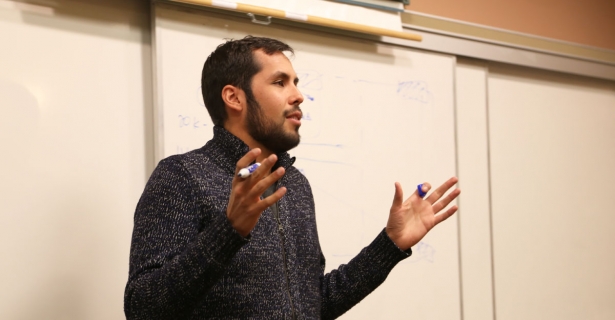As part of the Institute for Global Leadership’s Student Speaker Series on Migration this spring, Tufts’ New Initiative for Middle East Peace (NIMEP) brought Michael Nikconchuk (A’11) to campus to speak about his experience working for Questscope in the Za’atari Refugee Camp in Jordan. Niconchuk is a Tufts and IGL alumnus who led BUILD and founded the Oslo Scholars Program at the IGL. Since departing the Tufts campus, he has crafted a highly original and deeply substantive path. Today, he is a Senior Researcher at Beyond Conflict, where he merges his academic background in International Relations and Social Cognition with his experiences as a consultant to several international organizations in the Middle East and Europe and experience working as Emergency Response Coordinator at Questscope in Amman, Jordan.
Niconchuk explained that, shortly after graduating from Tufts, he discovered Questscope. Based in Jordan, Questscope provides a number of services to refugee populations - primarily education and mentorship - and is committed to hiring Jordanian employees. He described how, both endearingly and impressively, he talked his way into an internship at Questscope, wielding his Arabic language skills in particular. That was 2012.
The Syrian Civil War began in 2011 as part of the Arab Spring, its most destructive crisis that continues today, into its eighth year. Niconchuk’s arrival in Jordan coincided with the first spikes in the refugee crisis. Between August of 2013 and April of the following year, the number of Syrian refugees in Jordan increased from 20,000 to 140,000, and his work with Questscope became increasingly urgent. After a few months as an intern, Niconchuk was hired as an Emergency Response Coordinator and would spend the next three years serving the Za’atari Refugee Camp.
About Za’atari
Za’atari was opened in July of 2012 on a parcel of land one hour north of Jordan’s capital, Amman, and less than twenty kilometers south of the Syrian border. The camp filled rapidly, with an influx of up to 4,000 refugees per day. By March 2013, a second camp was opened to the east as Za’atari had surpassed its capacity of 60,000 refugees. The number of people in the camp at any time is hard to estimate, Niconchuk explained, because people enter and exit the camp unofficially. He spoke to the challenges with Za’atari that contribute to this.
A robust internal, informal economy has developed inside Za’atari. As refugees arrive, they are assigned small plots of land in the camp. But overtime, more members of a family might arrive, but be assigned to a different area. Instead of staying where they are registered, refugees consolidate the land parcels, turning some into rentable properties. In short, a system of privatization developed, with “landlords” renting out parcels for residential or commercial purposes. Refugees smuggled in produce, cigarettes, and any number of goods, selling them in shops or setting up cafes that eventually would turn streets in the camp into something of commercial blocks. Niconchuk said there is even one called the “Champs-Elysees.”
Electricity, too, became commodified. Because the UN does not consider electricity a human right, it is not provided in refugee camps. But the refugees that the UN was used to working with usually arrived with just the clothes on their backs and often did not come from areas with modern amenities. Za’atari was different. Many of the refugees from Syria were middle class, used to modern amenities. Coming from a range of professional backgrounds, they had a need to charge phones, laptops, etc. The electrical grid provided for police stations and NGO compounds was eventually hacked, and electricity started to be accessed throughout the camp. The challenges to the informal electricity could lead to risks, such as electrified puddles that claimed the lives of children, fires (at one point, a fire claimed one-fifth of the camp), grid blowouts, and 1.1 million Euro per month electric bills that no donors wanted to pay. Three weeks before Niconchuk’s talk, the camp inaugurated a solar grid.
Za’atari faced additional logistical challenges that were caused not only by the rapid influx of refugees but by the fact that the Jordanian government wanted Za’atari to be temporary. For example, the camp relied on makeshift latrines rather than a sewage system necessary for a large and long-term population. Since the camp sits on an aquifer, refugees faced infection and disease from groundwater contamination. Further, the latrines were frequent sites of sexual assault.
The UNHCR manages the camp along with the Jordanian Government and is supported by a number of aid organizations and Jordanian agencies. For Questscope, Niconchuk ran education and programming for the camps’ youth (of which there were approximately 26,000 in 2013), in an effort to ameliorate the interruption to their educations and childhoods as much as possible.
He described the realities of Za’atari without omitting harsh or unpleasant details, or the devastating reality that the refugee crisis is not likely to lessen in coming years. But his talk revealed the work to be done and the need to restructure the services offered to refugees, from updating what are considered basic human rights to how camps approach the question of permanence.

